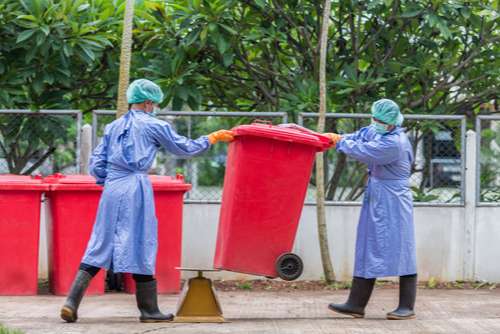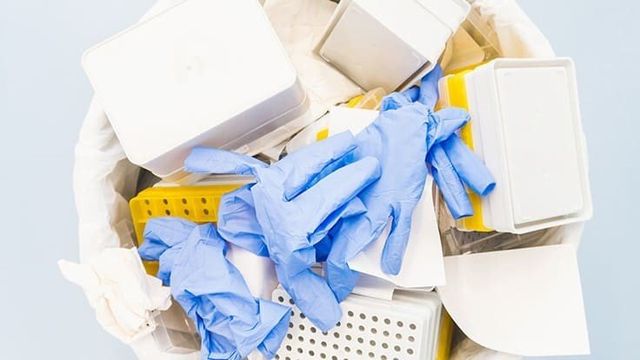Medical Waste Removal Mastery: Where Service Excellence Meets Health And Wellness Specifications
Remain Ahead of Laws: Professional Suggestions on Medical Garbage Disposal
In a world where the healthcare sector is regularly advancing, it is vital for medical centers to stay ahead of laws when it comes to the appropriate disposal of medical waste. From understanding the various categories of clinical waste to carrying out the right collection and partition techniques, this discussion will certainly provide valuable understandings and actionable pointers to help centers stay ahead of regulations in the ever-changing landscape of medical waste disposal.
Recognizing Medical Waste Categories
Recognizing medical waste groups is vital for appropriate disposal and monitoring in healthcare centers. Clinical waste refers to any kind of waste generated by medical care activities that may pose a risk to public wellness or the environment. It is critical to categorize clinical waste properly to ensure its risk-free handling, disposal, therapy, and transportation.
There are a number of groups of medical waste that health care centers require to be familiar with. The most typical groups consist of infectious waste, pathological waste, sharps waste, pharmaceutical waste, and chemical waste. Each classification has certain standards and regulations for its correct management and disposal.
Contagious waste includes products polluted with blood or various other physical fluids, such as gloves, gowns, and laboratory cultures. Pathological waste describes human tissues, organs, or body parts that require special delivery and disposal. Sharps waste includes utilized needles, syringes, and various other sharp things that can create injury and send infections. Drug waste consists of run out, extra, or infected medications that need cautious handling and disposal. Finally, chemical waste includes solvents, disinfectants, and other chemical substances used in healthcare facilities.
Staying Up-To-Date With Regulatory Changes
Remaining present with regulatory changes is essential for healthcare facilities to ensure conformity and appropriate management of medical garbage disposal. medical waste removal services. With laws regularly developing, it is vital for health care centers to stay current to prevent charges, fines, and possible harm to the atmosphere and public wellness
To stay in advance of regulatory changes, health care centers need to establish a system for monitoring and monitoring updates. This can be done by registering for regulative e-newsletters, attending workshops and seminars, and proactively taking part in market organizations. Furthermore, facilities need to designate a team member or team in charge of remaining informed and distributing information to relevant stakeholders.
Regular communication with governing firms is likewise vital. Healthcare facilities should develop connections with regional, state, and federal firms to ensure they know any type of modifications in regulations that may impact their waste administration techniques. This can be done via routine conferences, participation in public remark periods, and proactive involvement with governing firms.
Additionally, medical care centers must consider partnering with waste monitoring companies that focus on clinical waste disposal (medical waste disposal services with WasteX). These business are typically skilled in the newest policies and can provide support and assistance to make sure conformity
Executing Correct Collection and Partition Approaches
To efficiently take care of medical garbage disposal, healthcare centers should establish proper collection and segregation approaches according to governing standards. Carrying out these methods makes sure the risk-free handling and disposal of possibly unsafe materials, safeguards the environment, and lessens the danger of injuries and infections to medical care medical waste disposal services with WasteX employees and the public.
Appropriate collection and segregation approaches include using designated containers and identifying systems. Health care centers must give plainly classified containers for various sorts of medical waste, such as sharps, contagious waste, pharmaceutical waste, and non-hazardous waste. These containers need to be color-coded and clearly marked to prevent confusion and promote easy recognition.
Furthermore, healthcare centers must train their staff on the proper procedures for collecting and setting apart clinical waste. This consists of educating them on the various types of waste, the appropriate containers to make use of, and the importance of adhering to standards and regulations. Normal training sessions and correspondence course must be conducted to make certain that personnel participants remain updated on finest methods.
Additionally, medical care facilities need to develop a system for normal collection and disposal of clinical waste. This may entail partnering with accredited waste management companies that concentrate on medical garbage disposal. These firms will make sure that the gathered waste is carried and dealt with in conformity with governing requirements.
Selecting the Right Disposal Approaches

Incineration is just one of one of the most effective and common methods for taking care of certain kinds of clinical waste, such as pathological waste and sharps. It entails the regulated burning of waste at high temperature levels, lowering it to ash. Incineration can launch unsafe toxins right into the air and add to air pollution.

Chemical treatment involves the use of chemicals to reduce the effects of the waste and sanitize. Microwave therapy utilizes microwave energy to warm and disinfect the waste.
Making Sure Conformity With Documentation and Training
After thoroughly considering the appropriate disposal methods for clinical waste, healthcare facilities need to ensure conformity with policies and lessen ecological effect by implementing reliable documents and training treatments. This action is important in maintaining a secure and sustainable setting for both medical care employees and the general public.

Medical care employees who deal with medical waste ought to receive appropriate training on waste segregation, handling, and disposal treatments. By giving comprehensive training, medical care centers can equip their personnel to make educated decisions and minimize the threat of inappropriate waste disposal.
Verdict
In verdict, staying ahead of regulations in clinical garbage disposal is essential for medical care centers. medical waste removal near me. Comprehending the various classifications of medical waste, remaining updated with regulative changes, implementing correct collection and partition methods, choosing the ideal disposal techniques, and making sure compliance via documents and training are his explanation all vital steps. By following these standards, healthcare organizations can successfully manage and dispose of clinical waste in a liable and risk-free manner
From recognizing the different groups of medical waste to implementing the appropriate collection and segregation methods, this conversation will give actionable suggestions and valuable insights to aid facilities remain in advance of policies in the ever-changing landscape of clinical waste disposal. - medical waste disposal services with WasteX
The most typical groups consist of transmittable waste, pathological waste, sharps waste, pharmaceutical waste, and chemical waste. Healthcare facilities should offer clearly identified containers for different types of medical waste, such as sharps, contagious waste, pharmaceutical waste, and non-hazardous waste. Health care facilities should establish an extensive system to tape-record and track all elements of medical waste disposal, including types of waste generated, amounts, and disposal approaches made use of. Health care workers who deal with medical waste should get proper training on waste segregation, managing, and disposal procedures.